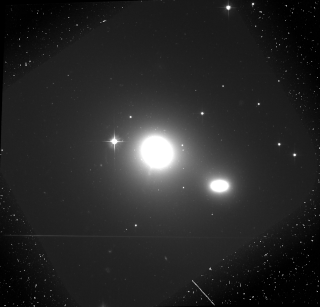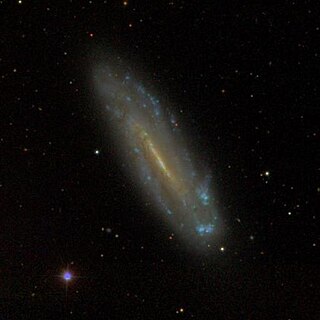Related Research Articles

A supercluster is a large group of smaller galaxy clusters or galaxy groups; they are among the largest known structures in the universe. The Milky Way is part of the Local Group galaxy group, which in turn is part of the Virgo Supercluster, which is part of the Laniakea Supercluster. The large size and low density of superclusters means that they, unlike clusters, expand with the Hubble expansion. The number of superclusters in the observable universe is estimated to be 10 million.

The Virgo Supercluster or the Local Supercluster is a mass concentration of galaxies containing the Virgo Cluster and Local Group, which itself contains the Milky Way and Andromeda galaxies, as well as others. At least 100 galaxy groups and clusters are located within its diameter of 33 megaparsecs. The Virgo SC is one of about 10 million superclusters in the observable universe and is in the Pisces–Cetus Supercluster Complex, a galaxy filament.
The Sunyaev–Zeldovich effect is the spectral distortion of the cosmic microwave background (CMB) through inverse Compton scattering by high-energy electrons in galaxy clusters, in which the low-energy CMB photons receive an average energy boost during collision with the high-energy cluster electrons. Observed distortions of the cosmic microwave background spectrum are used to detect the disturbance of density in the universe. Using the Sunyaev–Zeldovich effect, dense clusters of galaxies have been observed.

The Sloan Great Wall (SGW) is a cosmic structure formed by a giant wall of galaxies. Its discovery was announced from Princeton University on October 20, 2003, by J. Richard Gott III, Mario Jurić, and their colleagues, based on data from the Sloan Digital Sky Survey.

NGC 4536 is an intermediate spiral galaxy in the constellation Virgo located about 10° south of the midpoint of the Virgo cluster. However, it is not considered a member of the cluster. Rather, it is a member of the M61 Group of galaxies, which is a member of the Virgo II Groups, a series of galaxies and galaxy clusters strung out from the southern edge of the Virgo Supercluster. The morphological classification in the De Vaucouleurs system is SAB(rs)bc, which indicates it is a weakly barred spiral galaxy with a hint of an inner ring structure plus moderate to loosely wound arms. It does not have a classical bulge around the nucleus.

NGC 5247 is a face-on unbarred spiral galaxy located some 60 million light years away in the constellation Virgo. It is a member of the Virgo II Groups, a series of galaxies and galaxy clusters strung out from the southern edge of the Virgo Supercluster. This is a grand design spiral galaxy that displays no indications of distortion caused by interaction with other galaxies. It has two spiral arms that bifurcate after wrapping halfway around the nucleus. The disk is estimated to be 4.9 ± 2.0 kly (1.5 ± 0.6 kpc) in thickness and it is inclined by roughly 28° to the line of sight.

NGC 3344 is a relatively isolated barred spiral galaxy located 22.5 million light years away in the constellation Leo Minor. This galaxy belongs to the group known as the Leo spur, which is a branch of the Virgo Supercluster. NGC 3344 has the morphological classification (R)SAB(r)bc, which indicates it is a weakly barred spiral galaxy that exhibits rings and moderate to loosely wound spiral arms. There is both an inner and outer ring, with the prominent arms radiating outward from the inner ring and the slightly elliptical bar being situated inside. At the center of the bar is an HII nucleus with an angular diameter of about 3″. NGC 3344 hosted supernova SN 2012fh, which was shown to likely be a Type Ib or Type Ic.

The Pavo-Indus Supercluster is a neighboring supercluster located about 60–70 Mpc (196–228 Mly) away in the constellations of Pavo, Indus, and Telescopium. The supercluster contains three main clusters, Abell 3656, Abell 3698, and Abell 3742.

3C 66B is an elliptical Fanaroff and Riley class 1 radio galaxy located in the constellation Andromeda. With an estimated redshift of 0.021258, the galaxy is about 300 million light-years away.

In cosmology, galaxy filaments are the largest known structures in the universe, consisting of walls of gravitationally bound galaxy superclusters. These massive, thread-like formations can reach 80 megaparsecs h−1 and form the boundaries between large voids.

NGC 5545 is a spiral galaxy in the northern constellation of Boötes. It is interacting with the barred spiral galaxy NGC 5544.

Cosmic voids are vast spaces between filaments, which contain very few or no galaxies. The cosmological evolution of the void regions differs drastically from the evolution of the Universe as a whole: there is a long stage when the curvature term dominates, which prevents the formation of galaxy clusters and massive galaxies. Hence, although even the emptiest regions of voids contain more than ~15% of the average matter density of the Universe, the voids look almost empty for an observer. Voids typically have a diameter of 10 to 100 megaparsecs ; particularly large voids, defined by the absence of rich superclusters, are sometimes called supervoids. They were first discovered in 1978 in a pioneering study by Stephen Gregory and Laird A. Thompson at the Kitt Peak National Observatory.
In cosmology, intensity mapping is an observational technique for surveying the large-scale structure of the universe by using the integrated radio emission from unresolved gas clouds.

NGC 4178 is the New General Catalogue identifier for a barred spiral galaxy in the equatorial constellation of Virgo. It was discovered April 11, 1825 by English astronomer John Herschel. Located some 43.8 million light years away, this galaxy spans 2.3 × 0.4 arc minutes and is seen at a low angle, being inclined by 77° to the line of sight from the Earth. The morphological classification of NGC 4178 is SB(rs)dm, indicating that it has a bar feature at the core, and, per the '(rs)', has traces of a ring-like structure surrounding the bar. The 'dm' suffix indicates the spiral arms are diffuse, broken, and irregular in appearance with no bulge at the nucleus. This galaxy is a member of the Virgo Cluster, which is the richest nearby group of galaxies outside the Local Group and forms the core of the Virgo Supercluster.

The NGC 4065 Group is a group of galaxies located about 330 Mly (100 Mpc) in the constellation Coma Berenices. The group's brightest member is NGC 4065 and located in the Coma Supercluster.
The Telescopium−Grus Cloud is a galaxy filament in the constellations of Pavo, Indus, and Telescopium. It was first defined by astronomer Brent Tully in his book The Nearby Galaxies Atlas and its companion book The Nearby Galaxies Catalog.
References
- ↑ "The Las Campanas Redshift Survey". qold.astro.utoronto.ca. Archived from the original on 2012-06-30. Retrieved 2016-12-26.
- ↑ Shandarin, Sergei F.; Yess, Capp (1998). "Detection of Network Structure in the Las Campanas Redshift Survey". The Astrophysical Journal. 505 (1): 12–17. arXiv: astro-ph/9705155 . Bibcode:1998ApJ...505...12S. doi:10.1086/306135. S2CID 18220980.
- ↑ Bharadwaj, S.; Gupta, A. K.; Seshadri, T. R. (1999). "Nature of clustering in the Las Campanas redshift survey". Astronomy and Astrophysics . 351: 405–412. arXiv: astro-ph/9903252 . Bibcode:1999A&A...351..405B.
- ↑ Einasto, J.; Einasto, M.; Hütsi, G.; Saar, E.; Tucker, D. L.; Tago, E.; Müller, V.; Heinämäki, P.; Allam, S. S. (2003). "Clusters and Superclusters in the Las Campanas Redshift Survey". Astronomy and Astrophysics. 410 (2): 425–443. arXiv: astro-ph/0304546 . Bibcode:2003A&A...410..425E. doi:10.1051/0004-6361:20031105. S2CID 14486062.
- ↑ Bharadwaj, S., Sahni, V., Sathyaprakash, B.S., Shandarin, Sergei F., Yess, Capp (2000). "Evidence for Filamentarity in the Las Campanas Redshift Survey". The Astrophysical Journal. 528 (1): 21–29. arXiv: astro-ph/9904406 . Bibcode:2000ApJ...528...21B. doi:10.1086/308163. S2CID 10427122.
{{cite journal}}: CS1 maint: multiple names: authors list (link) - ↑ Bharadwaj, Somnath; Bhavsar, Suketu; Sheth, Jatush V. (2004). "The Size of the Longest Filaments in the Universe". The Astrophysical Journal. 606 (1): 25–31. arXiv: astro-ph/0311342 . Bibcode:2004ApJ...606...25B. doi:10.1086/382140. ISSN 0004-637X. S2CID 10473973.
- ↑ Bharadwaj, Somnath; Pandey, Biswajit (2004). "Using the filaments in the LCRS to test the LambdaCDM model". The Astrophysical Journal. 615 (1): 1–6. arXiv: astro-ph/0405059 . doi: 10.1086/424476 . ISSN 0004-637X.